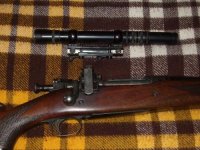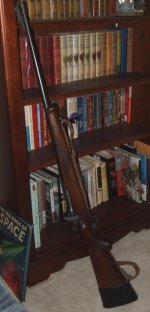M
Montana Pete
Guest
Here are some photos of a "classic" sporting rifle circa 1932.
If anyone reads Maj. Crossman's "Book of the Springfield," you will discover that just about the whole game for first-class sporter rifles in 1930 was sporterized Springfields. A chapter or two describes the Model 54 Winchester, which came out for the first time in about 1934 with the .270 Winchester. The Model 54 was an obvious knock-off, or imitation, of the sporterized Springfield. As many of you know, the Model 54 Winchester was the immediate predecessor of the famous Model 70 Winchester sporting rifle. The inspiration of both the Model 54 and the Model 70 was the sporterized Springfield -- and, earlier than that, the German Mauser action, which goes back as far as 1895.
Anyway, here is a "classic." Sorry if the photos are not as good as the gun deserves.
This rifle was a sporterized version of the 03. Some later rifles are described as an 03A3, but I believe this baby was the older 03. She has a star-guage barrel, which is revealed by a small star emblem stamped below the muzzle aperture, on the crowning.
This rifle has Lyman receiver sights, but -- as you can see-- of a sophistication beyond anything that Lyman or Redfield are selling today. Quarter-minute clicks, etc.
If the Lyman sight is removed, a scope can be slid onto the rifle via a left-side rail mount. This is a Leopold, and is shown in one of the photos. Many years ago, in about 1985, I sent the scope back to Leopold for work, based on their "lifetime guarantee." Incredibly, they fixed this scope, even though it is a museum item. They wrote a very respectful personal letter telling me what a pleasure it was to maintain this scope. The crosshairs are horsehide, and have a bit of "waviness"to them. Due to humidity effects on this organic material. The scope still shoots fine. It is-- as best I recall-- a 2-1/2 X.
This rifle was used by my dad, Harry B. Callahan, to earn an Expert medal with at least six bars. I believe in the 1930's it was previous to there being such a thing as a "master's" medal. Expert was as high as you could go. Each bar required shooting expert three successive years.
This rifle took a lot of big game, including grizzlies, elk, moose, and more.
The gun has not been fired in 25 years, but I have obtained some fresh brass and a couple of boxes of match-quality bullets, and will have the old girl shooting again within the next two weeks.
Anyone can see from the photos that this old rifle has seen much wear, but has been beautifully maintained. The wear is "dignified wear." As far as I know, the gun still shoots fine, although it probably needs long bearing-surface bullets, since there's been some throat erosion just from number of rounds this rifle has put down-range. I will be reloading her with Sierra 180 gr. Matchkings.
Thought some of you old-timers would like to go down memory lane with this fine old classic Springfield.
If anyone reads Maj. Crossman's "Book of the Springfield," you will discover that just about the whole game for first-class sporter rifles in 1930 was sporterized Springfields. A chapter or two describes the Model 54 Winchester, which came out for the first time in about 1934 with the .270 Winchester. The Model 54 was an obvious knock-off, or imitation, of the sporterized Springfield. As many of you know, the Model 54 Winchester was the immediate predecessor of the famous Model 70 Winchester sporting rifle. The inspiration of both the Model 54 and the Model 70 was the sporterized Springfield -- and, earlier than that, the German Mauser action, which goes back as far as 1895.
Anyway, here is a "classic." Sorry if the photos are not as good as the gun deserves.
This rifle was a sporterized version of the 03. Some later rifles are described as an 03A3, but I believe this baby was the older 03. She has a star-guage barrel, which is revealed by a small star emblem stamped below the muzzle aperture, on the crowning.
This rifle has Lyman receiver sights, but -- as you can see-- of a sophistication beyond anything that Lyman or Redfield are selling today. Quarter-minute clicks, etc.
If the Lyman sight is removed, a scope can be slid onto the rifle via a left-side rail mount. This is a Leopold, and is shown in one of the photos. Many years ago, in about 1985, I sent the scope back to Leopold for work, based on their "lifetime guarantee." Incredibly, they fixed this scope, even though it is a museum item. They wrote a very respectful personal letter telling me what a pleasure it was to maintain this scope. The crosshairs are horsehide, and have a bit of "waviness"to them. Due to humidity effects on this organic material. The scope still shoots fine. It is-- as best I recall-- a 2-1/2 X.
This rifle was used by my dad, Harry B. Callahan, to earn an Expert medal with at least six bars. I believe in the 1930's it was previous to there being such a thing as a "master's" medal. Expert was as high as you could go. Each bar required shooting expert three successive years.
This rifle took a lot of big game, including grizzlies, elk, moose, and more.
The gun has not been fired in 25 years, but I have obtained some fresh brass and a couple of boxes of match-quality bullets, and will have the old girl shooting again within the next two weeks.
Anyone can see from the photos that this old rifle has seen much wear, but has been beautifully maintained. The wear is "dignified wear." As far as I know, the gun still shoots fine, although it probably needs long bearing-surface bullets, since there's been some throat erosion just from number of rounds this rifle has put down-range. I will be reloading her with Sierra 180 gr. Matchkings.
Thought some of you old-timers would like to go down memory lane with this fine old classic Springfield.
Attachments
Last edited by a moderator:





